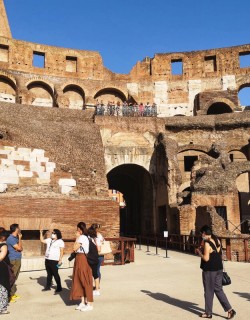Rainy, foggy London seems more likely to be full of ghosts than sunny Rome. Despite its ancient history and countless violent deaths, Rome simply seems too Mediterranean to be haunted. But if you go on a tour of Rome after dark, you'll see another side of the city, and discover that ghosts are everywhere – crossing the Tiber, lingering behind palazzo windows, and even harassing young men in Piazza Navona…
The Cold of the Colosseum
You would expect the Colosseum to be haunted by at least a few ghosts, as hundreds of thousands of slaves, gladiators and wild animals met their untimely end in the arena. There have been reports of screams, growls, ghostly figures on the stairs and cold patches of air.
Sceptics will point out that the interior of the Colosseum is cold because of all the stone, but some believe that there’s a more supernatural explanation. The tunnels below the Colosseum, which were once crowded with gladiators and slaves preparing for combat, are particularly chilly, and it’s impossible to walk through the Gate of Death without getting goosebumps.
If you go on an Underground Colosseum Tour, we can’t guarantee that you’ll see a ghost, but you’ll definitely notice a strange, unsettling atmosphere. And the cold. Even in the height of summer, you’ll feel the cold.
Nero in the walnut tree
After Nero committed suicide, he was buried on the Pincian Hill, which now overlooks Piazza del Popolo. Legend has it that after his death, he took the form of black crows and feasted with witches and demons in a nearby walnut tree. Considering Nero’s hedonistic parties at the Domus Aurea, perhaps it’s not surprising that he continued to feast in the afterlife.
In the eleventh century, in an attempt to chase away Nero’s troublesome ghost, the pope had the tree cut down, and a chapel built in its place. If you visit the church of Santa Maria del Popolo in the hope of catching a glimpse of the emperor, however, you’ll be disappointed, as the pope’s plan seems to have worked. Ever since the construction of the church, there have been no sightings of Nero’s ghost.
The promiscuous empress Messalina
Valeria Messalina, the young wife of the emperor Claudius, was infamous for her promiscuity. Serially adulterous, she allegedly once challenged Rome’s most famous prostitute to a contest, to see who could have the most sexual partners in one evening. Messalina won, with a score of twenty five. Juvenal also claimed that the empress regularly worked in a brothel, under the name “She-Wolf”.
While such stories were probably greatly exaggerated, if not completely invented, there’s no doubt that Messalina’s behaviour displeased her husband. Claudius had turned a blind eye to Messalina’s infidelity until she finally went too far, marrying a Roman senator and plotting to overthrow Claudius, so she could replace him with her new husband. This was the final straw; Claudius sent a courier to order Messalina to commit suicide. According to Tacitus, “she understood her fate and put her hand to the dagger. In her terror she was applying it ineffectually to her throat and breast, when a blow from the tribune drove it through her.”
Claudius was also unlucky with his next wife, Agrippina, who is rumoured to have poisoned him with mushrooms. There have been no sightings of Claudius’s ghost, but Messalina lives on. She is reported to haunt the Coppian Hill near the Colosseum, looking for a new lover, and there are even rumours that she pinches the bottoms of young men in Piazza Navona. The story of the insatiable empress was too good to end with her death, so it’s no surprise that she continues to walk the streets of Rome.
The lost hand of Costanza Conti de Cupis
Palazzo Cupis on Via di Santa Maria dell’Anima is rumoured to be haunted by the ghost of a seventeenth century woman, Costanza. This young woman was said to be one of the prettiest in Rome, graced with particularly beautiful hands. A sculptor made a stone copy of one of her hands and displayed it in his studio. One day a stranger visited the studio and, looking at the stone hand, said that the woman who the hand belonged to would soon lose it.
Shortly afterwards, Costanza pricked her finger while doing some needlework. The injury became infected and spread, leading to the amputation of Costanza’s hand, and then her death from septicaemia. If you’re near Palazzo Cupis one night when there’s a full moon, look up at the window. You might see a ghostly hand…
The tragic life of Beatrice Cenci
One of the most famous ghosts in Rome is another young woman, Beatrice Cenci, whose story has inspired countless paintings, poems and plays. She was the daughter of the tyrannical aristocrat Francesco Cenci, who famously abused his wife and daughter. His family plotted to have him killed, and had him pushed over a balcony to make it look like an accident. When the plot was discovered, Beatrice, her brothers and step-mother were tortured and sentenced to death.
The people of Rome protested against the decision, and there was considerable public sympathy for the condemned members of the Cenci family. But on 11 September 1599, Beatrice was led to the scaffold on Ponte Sant’Angelo and decapitated in front of her twelve year old stepbrother, who was forced to watch the executions of his family.
On the anniversary of her death, Beatrice can be seen carrying her severed head as she walks across Ponte Sant’Angelo. As well as haunting the place of her death, she is also said to haunt the house where she spent her short, tragic life. Modern inhabitants of her old family home in the Jewish Ghetto, Palazzo Cenci, have seen her beautiful, melancholy ghost, and heard her weeping.
To learn more about the dark past of Rome, and to explore the back streets of the Jewish Ghetto, join our Secret Rome Tour.
~by Alexandra Turney~


